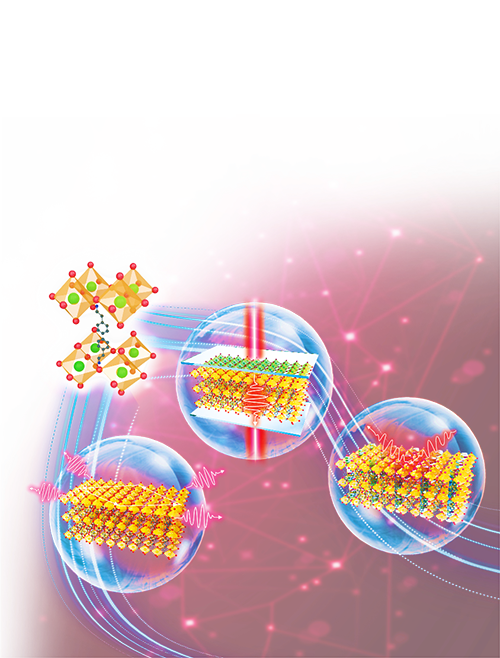The pursuit of optical-electrics with small size, integration and fast operation requires the efficient control of photon coupling and propagation at nanoscale. The coupling of luminescent medium to optical cavity promotes the directional transmission and reduce the loss of light. Moreover, the confined light can interact with medium.
The choices of gain materials have significant effects to optical cavities. On the one hand, the high quantum efficiency of gain materials can reduce the nonradiative processes; on the other hand, the ease of integration with high -quality optical cavity improves the quality factor of optical modes.
In recent years, people have found room-temperature, highly efficient excitonic emission of lead -halide perovskites. Meanwhile, Auger recombination at high carrier density is also relatively low. In addition, high-quality single crystal perovskites can be easily produced by solution methods or chemical vapor deposition (CVD). All of these make perovskite advantageous materials for photonic devices.
Room-temperature LEDs, optical pumped lasing and exciton-polariton have been obtained in three-dimensional (3D) perovskites ABX3 (A=CH3NH3, CH(NH2)2, Cs; B= Cl, Br, I). However, the relative low value of exciton binding energy together with high trap density gives the way to investigate the emissive properties and applications of low dimensional perovskites.
In two dimensional perovskites, the steric effects of large organic cations induce the separation of inorganic frameworks by organic layers and lead to dielectric screen and quantum confinement effect. In spectroscopy, this can be viewed as the excitonic absorption and emission varied with different inorganic layer number. Due to their two-dimensional (2D) layered property and relative high quantum efficiency, they have unique advantages in optical cavity engineering at nano/micro size.
So far cavity applications of 2D perovskites have gained broad interests, yet with a series of problems. Questions need to be answered such as the demand of cavity construction considering the unique properties of 2D perovskites, the arrangement of suitable cavity structures and morphology of 2D perovskites.
In view of the current research status, Prof. Xinfeng Liu's group from National Center for Nanoscience and Technology made constructive discussions on the cavity application of 2D perovskites and inherent light-matter interaction. The review is selected to be on the Cover of Photonics Research, vol. 11, 2020 (Shuai Zhang, Yangguang Zhong, Fan Yang, et al. Cavity engineering of two-dimensional perovskites and inherent light-matter interaction[J]. Photonics Research, 2020, 8(11): 11000A72).
The review initially discusses the unique optical properties of 2D perovskites, and makes comparison with 3D perovskites. Firstly, higher quantum yield, lower trap density and more excitonic emission can be expected in 2D perovskites. In addition, optical anisotropy of 2D perovskite can be generated by the coexistence of in-plane and out of plane optical transition routes, which is different from many 2D materials such as transition metal cluster chalcogenides. The scattering between exciton and lattice of 2D perovskites results in the exciton-phonon coupling. Moreover, localized excitons induce the deformation of surrounding lattice, and self-trapped excitonic emission can be easily occurred in 2D perovskites.
The next section of this review introduces the synthesis of 2D perovskites and fabrication of their microcavities. Spin-coating thin film, solution crystallization and chemical vapor deposition (CVD) are used for material preparation. Based on the morphology of material source, different cavity structures can be fabricated, such as self-assembled cavity using single crystal micro structure of 2D perovskite, vertical Fabry–Pérot cavity and periodical cavity arrays like photonic crystal structure.

The construction of two-dimensional perovskite based optical cavities, including self-assembled single crystal cavity, vertical Fabry–Pérot cavity and photonic crystal structure.
The main content discusses the cavity application of 2D perovskites, including strong exciton-photon coupling, photonic laser and optoelectronic devices. In the field of strong coupling, the review summarizes the observation of strong coupling in different cavity structures. The quality factor of optical cavity plays an important role in the nonlinear performance of exciton polariton. Especially in the single crystal embedded distributed Bragg reflector cavity, spin-dependent polariton-polariton interaction and BEC have been observed. In the field of photonic laser, the review points that optical gain of single inorganic layer 2D perovskite is suppressed due to strong exciton-phonon coupling and Auger recombination processes. The obstacle is released in quasi 2D perovskite (multi inorganic layer). Hybrid quasi 2D perovskite could form fast excitonic transmission between different energy states and finally contribute to the optical gain on the lowest energy state. Finally, in the aspect of optoelectronic applications based on 2D perovskite cavities, the review indicates that optical cavity can enhanced the absorption and emission at certain energy region. This can improve the optoelectronic performance and promote the design of new-type of functional devices such as enhanced nonlinear two-photon absorption and 2D perovskite nanowire-based photon detector.
At last, the review discusses the opportunities and challenges of 2D perovskites-based cavity applications. In the field of material preparation, the controlled growth of large scale and high quality single crystal film is the next target. For the understanding of cavity mechanism, the influence of different dimensionality (from 2D to quasi-2D) to optical gain and the generation of exciton polariton need further exploration. 2D perovskite cavities have great potential in many functional devices such as nonlinear, integrated photonic devices. However the environmental stability and potential heavy metal pollution should also be considered.


